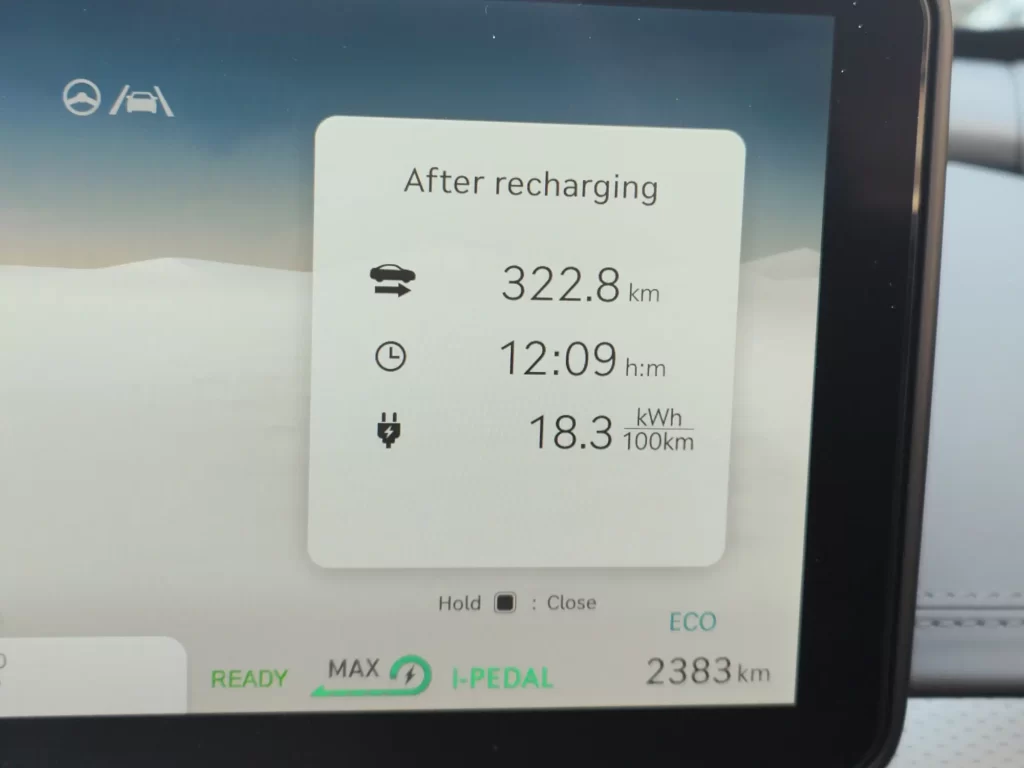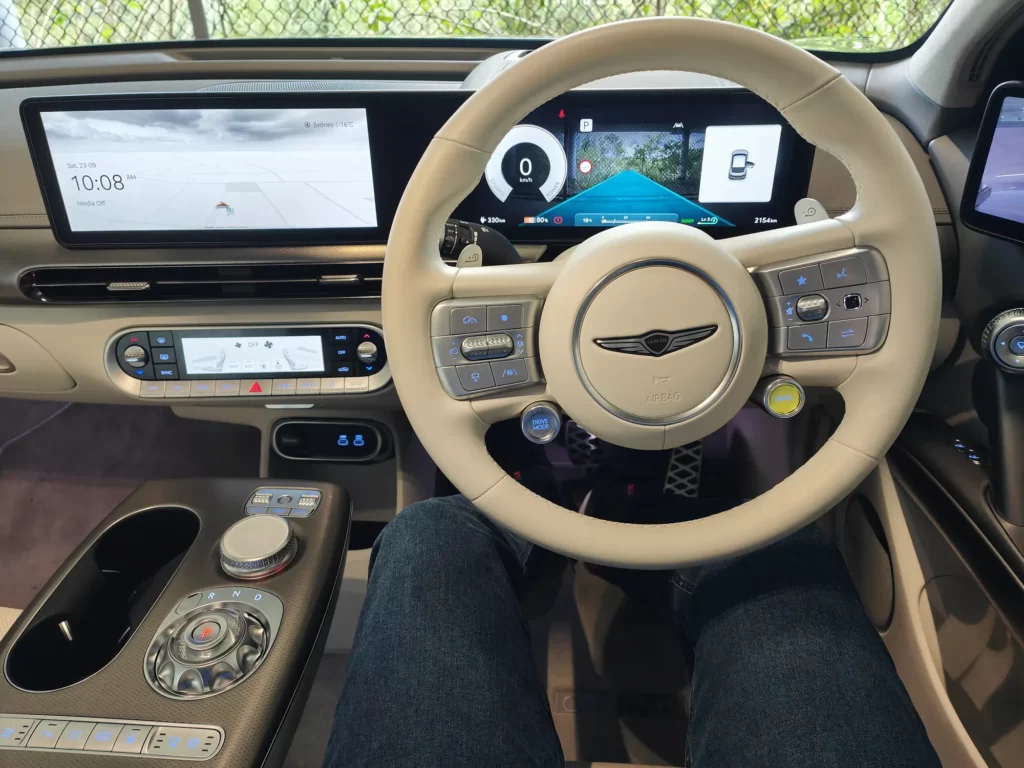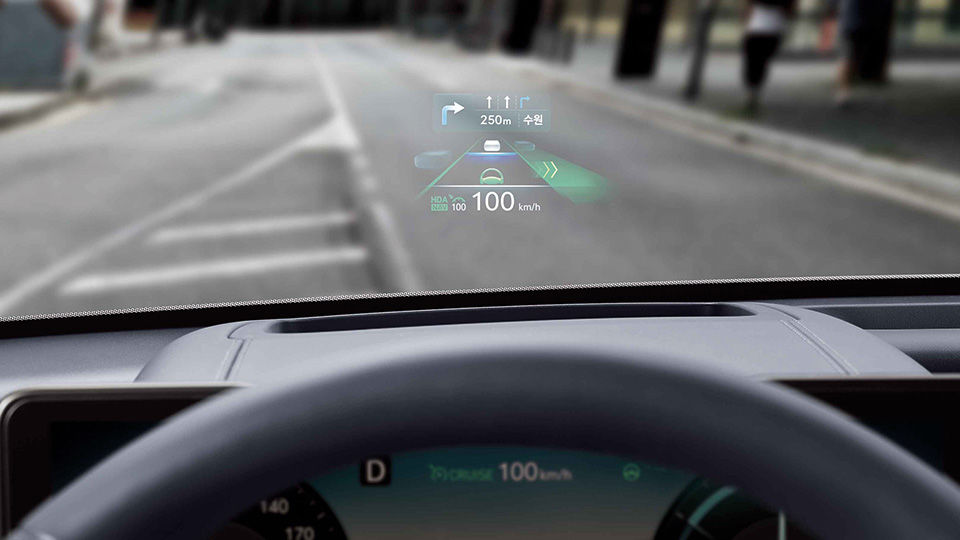
I recently drove 322km in a Australian Genesis GV60 Performance AWD electric car around Sydney. There were lots of short less than 10km trips as well as as longer trips to the Northern edges of Sydney at Cowan and Riverstone.
In Australia the Genesis GV60 is only available in two AWD spec levels, unlike the UK where more efficient and less expensive RWD spec levels are also available.
I had the top of the range AWD PERFORMANCE spec level in Barossa Burgundy on loan for review, which is $123,367.99 driveaway in NSW.
The car is rated at 19.1kWh/100km WLTP energy consumption and I achieved 18.3kWh/100km driving in Comfort mode most of the time.
Maximum torque is 700Nm (with Boost/Sport mode, 605Nm without or 350Nm in Eco if you want to reduce battery consumption while doing slower city commuter driving.
There are 3 driving modes in order of high to low range: eco, comfort and sport. In Sport mode the car seat gives you a hug on the sides all the time.
Disclosure: The car was loaned by Hyundai Australia for 11 days to review. I agreed to meet all the associated running costs e.g. tolls, charging etc.

What I Liked
Comfort
This is the most comfortable and relaxing EV I’ve driven to date across the board in terms of low noise, suspension, performance and seat comfort. After every hour of driving the seat gives your lower back a massage which is nice for longer journeys.
There is hardly any wind or road noise at motorway speed thanks to laminated glass and foam inserts in the tyres.
The secret to comfortable suspension for a such a heavy performance car weighing 2,210kg is Genesis Adaptive Control Suspension
(GACS) which is a combination of Road Preview-Electronic Control Suspension (Preview-ECS) & Dynamic Stability Damping Control (DSDC).
Pre-view ECS uses information gathered from the front camera and navigation system to look at the road ahead an recognize things like speed bumps in advance. It then controls the damping force of the suspension according to what it sees on the surface of the road to enable optimal comfort for the driver and passengers.
The front camera view can also be displayed behind the driver information cluster stats so even if you glance at that screen you’re still keeping eyes on the road. I really liked that feature.

Interior Technology and Usability
This is not a traditional luxury car as Hyundai Motor Group has included all the tech features from their Hyundai and Kia E-GMP electric cars as well as adding even more such as Fingerprint Authentication System (for User Profile selection and vehicle start) and Face Connect (Facial recognition for vehicle lock/unlock).
Genesis GV60 has lots of great interior tech such as two huge 12.3 inch screens for the driver information cluster and central infotainment.
Unlike some other EV brands just because there are big touch screens doesn’t mean there aren’t any buttons or other physical controls.
As you can see in the photo below the Genesis GV60 has plenty of physical controls that are easy to use without having to look at them eg buttons on the steering wheel, regen level control pedals behind steering wheel, locking and window controls on the door.

On the centre console there are even more buttons as well as crystal sphere to control gear changing/park and another knob that can be used to scroll through the infotainment menu.
Below the infotainment screen is a 6 inch temperature control screen and above the driver information cluster is a heads up display (Korean GV60 photo displayed below).

E-GMP Platform
Since the Genesis GV60 is based on Hyundai’s 800V E-GMP platform you get all the associated excellent features such as:
- Charging from 10-80% at a 350kW charger in 18 minutes
- External and Internal V2L (250V, 3.6kW, 15A)
- Lots of internal space
Interestingly the Genesis GV60 is a bit easier to park because it’s shorter in length than it’s cousins the Hyundai Ioniq 5 and Kia EV6.
Unlike the current generation Hyundai Ioniq 5 and Kia EV6 on Australian roads, the Genesis GV60 supports Over-The-Air updates, so car software can be upgraded to latest versions without visiting a service centre.
What Could Be Better
Digital Side Mirrors
The digital mirrors are a technology solution fixing a problem that doesn’t exist.
They are quite chunky in size so I doubt using them instead of traditional mirrors gains any meaningful range.
If they break off due to a parking error by you or damage by vandals they would be much more expensive to repair than traditional mirrors.
There are still two more problems.
One day I started driving in the morning and then had to pull over to clean the camera lens with my finger because a spider had decided to camp there overnight and build a web that blocked the camera vision.
Another day I started driving early morning and the camera had condensation on it so the view looked foggy for 5-10 min til the condensation disappeared. Several Australian Genesis GV60 owners have experienced this problem.
Internal Screens for Digital Mirrors
In such an expensive premium car I think the internal screens for the digital mirrors at the front corner of each door make the interior look cluttered. It’s like two small tablets have been stuck inside as an afterthought.
While I found the passenger side camera screen kind of useful, the driver side was uncomfortable because I’m tall and the line of sight is awkward with the screen inside the car much closer than an external mirror.
Secondly it was hard to focus on the screen at times, it’s much easier to focus on a distant object in a traditional car mirror than on a distant object on a nearby screen.
Thirdly I realised that if the car isn’t started yet then the Internal Screens for the digital mirrors display nothing!
For something meant to improve visibility digital mirrors and their associated internal screens are a fail in every way.
Doesn’t keep my preferred Regen Braking level
Like all other Hyundai and Kia EV’s you have to turn i-Pedal (one pedal driving) on for the Genesis GV60 every single time you turn the car on.
If you then put the car into reverse to get out of a parking spot i-Pedal turns off and has to be manually turned on again once you change to Drive mode.
This is really annoying and doesn’t have to be this way, looking at Genesis owner forums I’m not the only one who dislikes this.
Polestar 2 and Tesla EV’s always remember your preferred regen braking setting and keep it that way. Hyundai Motor Group please do the same.

Leave a Reply